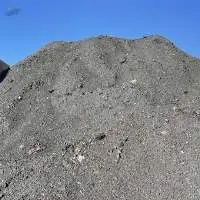
We are glad to propose 500 MT of stain less steel mill scale. Mill scale is formed on the outer surfaces during by the hot rolling lamination of stainless-steel products. At a visual inspection the material is a hard brittle sand and is mainly composed of iron oxides, mostly ferric, and is bluish black in colour, but it also contains considerable alloying elements such as chromium and nickel. The recovery ratio after melting in furnace for the most valuable alloy elements is: - Ni: 3.5 - 4.5% - Cr: 6-8% From the chemical and physical analysis performed on the scrap, and according to the European environmental rules, the material has been classified as a special non dangerous waste, listed in green list. In particular the mill scale can be classified as follows: Waste code: 10 02 10 The material is stored on cemented flooring, and it can be loaded loose in tipper trucks or containers. Chemical analysis of the material is available on request.
We are proposing about 1000 1200 Mt/ton monthly of iron slag derived from the desulphurisation skimming process. This material is a iron by- product that is encapsulated in varying levels of contaminants (S,Mg,Si). In order to enhance its usability, the material is processed and screened. We can propose two specifications of Iron Slag : 1. >85% Fe Average 600mm Max Fraction 2. >78% Fe Average 20-300mm Fraction The level of Fe% in the slag has been estimated by water displacement test. For any further information please feel free to contact
We are proposing about 2000tons of iron slag derived from the desulphurisation skimming process. This material is a iron by- product that is encapsulated in varying levels of contaminants (S,Mg,Si). In order to enhance its usability, the material is processed and screened. We can propose two specifications of Iron Slag - European Code: 19.12.01 - Basel Code: B1010 - HS Code: 2619.0020 - Quantity: 2000 tons currently available - Monthly quantity: 500-1000 tons depending on production - Size: 350 1200 mm - Fe content: from 77 to 86% - C content: above 2,5-3% - Bulk density: 2,8-3,4 tons/m3 - Loading type: loose in 20 (26-27 tons on average) The level of Fe% in the slag has been estimated by water displacement test. For any further information please feel free to contact us
We source high quality Ores and Others that are majorly used in numerous of Industries for diverse uses. The wide collection of Mineral Ores is free from impurities and rich in other essential features. Our esteemed client’s can avail the wide gamut of Mineral Ores at very pocket friendly price. We deal in * Bauxite ore * Copper ore * Lead ore * Nickel ore * NPI -Nickel pig iron * Tin ore * Zinc ore etc
Pipe fittings are the general names of parts and components that play the role of connection, control, direction change, diversion, sealing and support in the pipeline system. Steel fittings are pressure fittings. According to the different processing technology, it is divided into four categories, namely, butt welding pipe fittings (divided into weld and no weld), socket welding and threaded pipe fittings, flange pipe fittings. According to the application: 1. pipe fittings for connecting pipes are: flanges, live joints, pipe hoops, clamps, clamps, throat hoops, etc. 2. changing the direction of the pipe: bends, bends. 3. pipe fittings changing pipe diameter: variable diameter (different diameter pipe), different diameter elbow, branch pipe table, reinforcing pipe. 4. pipe fittings with additional piping branches: three links, four links. 5. pipe fittings for pipe sealing: gasket, raw material belt, thread, flange blind plate, pipe plug, blind plate, head, welding plug. 6. pipe fittings for pipe fixing: clasp, hook, ring, bracket, bracket, pipe clamp, etc. According to the connection :1, welded pipe fittings 2, threaded pipe fittings 3, clamping pipe fittings 4, clamping pipe fittings 5, socket pipe fittings 6, rubber ring connection pipe fittings According to the material divided into 1, cast steel pipe fittings 2, forged steel pipe fittings 3, alloy pipe fittings 4, stainless steel pipe fittings. Pipe fittings are widely used in municipal, petrochemical, west-to-east gas transmission, ships and nuclear power.
Applications: Use to manufacture gypsum panel or building plasters Use to make gypsum mold or statutes As grout of marble, clay and ceiling tiles As a color additive Act as additive to other products Types: 1. Super Micronized Gypsum Powder 2. Facade Rendering Gypsum Packaging: 25 kg per bag 30 kg per bag 50 kg per bag 1 ton jumbo bag 1.5 tons jumbo bag 2 tons jumbo bag
Our company has rich experience and expertise in supplying a wide array of Lead Ore that are used in making electrical equipments, radiators among other industries. They are fabricated using premium-quality raw-materials in compliance with the prevailing industrial standards of quality. They are offered to clients at affordable rates. The composition varies from client to client. We also export these quality-tested products to our esteemed overseas clients through reliable shipment modes.
Supplier: Talc, mica, fly ash, bauxite, calcined bauxite, potash feldspar, quartz, sand, silica sand, micro silica, silica fume, bentonite, bleaching clay, ball clay, ethyl acetate
Quartz: Quartz is one of the most well-known minerals on the earth with numerous uses. Sand, which is composed of tiny Quartz pebbles, is the primary ingredient for the manufacture of glass. We feel pride in introducing ourselves as a leading Quartz Lumps Exporters from India. Mineral-grade packaging is provided for safe and easy delivery of Quartz Lumps. We welcome orders from Middle East, East Asian and several other countries and ensure timely shipment. Applications : It is used as an abrasive for sandblasting, grinding glass and cutting of soft stones. Quartz powder is also used in ceramic tiles along with feldspar.






